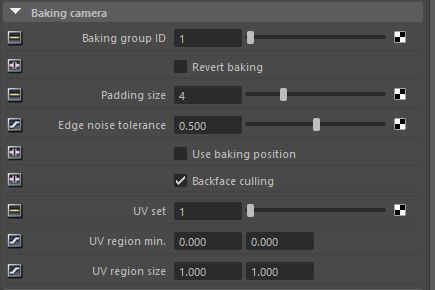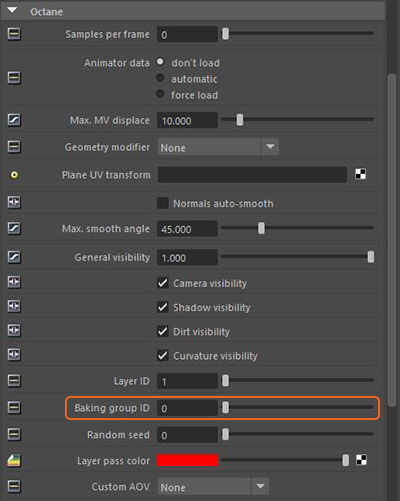
The Baking camera is meant for texture baking. This is a process where scene lighting is baked into a texture map based on an object's UV texture coordinates. You can map the resulting texture back onto the surface to create realistic lighting in a real-time rendering environment. This technique is often used in game engines and virtual reality for creating realistic environments.
In contrast to the Thin Lens and Panoramic cameras, the Baking camera has one position and direction per sample. Octane calculates these depending on the input UV geometry and the actual geometry being baked.
For each sample, the camera calculates the geometry position and normal, then it generates a ray that points towards the camera using the same direction as the normal from a distance of the configured kernel’s ray epsilon. Once calculated, Octane traces the ray the same way it traces with the other camera types.

Figure 1: The Baking Camera attributes
Baking Group ID - Specifies the baking group to bake. By default, all Objects belong to the default baking group number 1.
Revert Baking - Flips the Camera's direction.
Padding Size - The number of pixels added to the UV map edges. The padding size is specified in pixels. The default padding size is set to 4 pixels, with 0 being the minimum and 16 being the maximum size.
Edge Noise Tolerance - Helps remove hot pixels appearing near the UV edges. Values close to 1 do not remove any hot pixels, while values near 0 attempts to remove them all.
Use Baking Position - Using a baking position traces camera rays from the specified coordinates in world space instead of using the Mesh surface as reference. This is useful when baking position-dependent artifacts, such as the ones produced by GlossyThe measure of how well light is reflected from a surface in the specular direction, the amount and way in which the light is spread around the specular direction, and the change in specular reflection as the specular angle changes. Used for shiny materials such as plastics or metals. or SpecularAmount of specular reflection, or the mirror-like reflection of light photons at the same angle. Used for transparent materials such as glass and water. materials.
Backface Culling - This determines whether to bake back-facing geometry.
UV Set - This determines the UV coordinates to use for baking.
UV Region Minimum - The coordinates in UV space for the origin of the bounding region for baking.
UV Region Size - This is the size in UV space of the bounding region for baking.
The Mesh should contain at least one UV set. AlembicAn open format used to bake animated scenes for easy transfer between digital content creation tools. meshes can use up to three sets.
The Mesh shouldn't have overlapping UVs. Overlapping UVs occur when more than one mesh or mesh component shares the same UV texture coordinates. Overlapping geometry causes artifacts.

Figure 2: The orange square highlights an area of overlapping UV texture coordinates
After you create a scene that contains geometry, lighting, material information, etc., the first step is to create a camera and select Baking as the Octane Camera Type. Users often duplicate the main rendering camera in the scene and then set the duplicate's Octane Camera Type to Baking.
The next step is to match the object's Baking Group ID to the baking camera's Baking Group ID (Figure 3). For example, to bake a room's lighting into the textures for the walls (provided the walls do not have overlapping UVs), set the camera's Baking Group ID to 2 and each wall's Baking Group ID to 2, then you can render by using Maya's batch rendering or the IPRProvides artists a quick preview of the image prior to the final render, and efficiently allows for adjusting some elements in the scene such as lights, shaders and textures interactively. An IPR image contains shading and lighting data including some for visibility, in addition to the software render. window. If you want a separate texture for the floor, set the floor's Baking Group ID to 3 and the Camera's Baking Group ID to 3, then render until all the textures for the items in the room are baked. Each time you bake a texture, you save the image and then use the image as part of a texture map for the object as part of a shading network. You can bake any of the Octane AOVs into a texture.
If you have high resolution geometry that shares the same UV texture layout as a low resolution version of the same geometry, texture baking is a great way to create the look of high detail in low-polygon Meshes.

Figure 3: Setting up Baking Group IDs to match